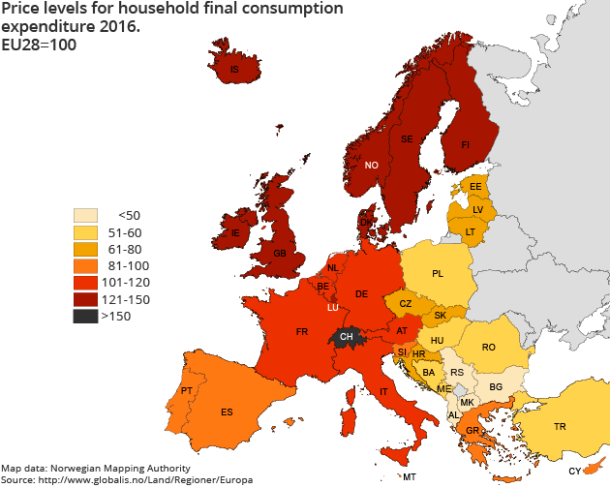EFTA countries the most expensive in Europe
Published:
The European statistics office (Eurostat) recently released calculations based on a price level survey conducted in all European countries. Results show that Norway had one of the highest price levels in Europe in 2016, particularly for alcoholic beverages and tobacco.
- Full set of figures
- Price level for consumer goods and services
EFTA countries Switzerland, Iceland and Norway had the highest price levels for Household Final Consumption Expenditure (HFCE), with 61, 47 and 40 per cent above the EU28 average respectively. The rest of the Nordic countries and Ireland had price levels between 39 and 21 per cent above the EU28 average. The majority of the countries in the Balkans had the lowest price levels in the survey. For example, Macedonia, Bulgaria, Albania and Serbia had price levels of around 50 per cent below the EU28 average.
Food, beverages and tobacco most expensive in Northern Europe
Switzerland together with Norway and Denmark had the highest price levels for food and non-alcoholic beverages in Europe. Macedonia, Poland and Romania had the lowest prices. For alcoholic beverages and tobacco, Norway and Iceland topped the list with prices around double that of the rest of Europe. The other Nordic countries as well as Ireland and the United Kingdom stand out as expensive in alcoholic beverages and tobacco. This is due to the high excise duties in these countries, particularly on alcoholic beverages. Amongst the Nordic countries, Norway had the highest excise duty, while Denmark had the lowest. The cheapest alcoholic beverages and tobacco were found in Macedonia, Serbia and Bosnia and Herzegovina.
Figure 1. Price levels in Norway according to ECOICOP division. Indices 2016. EU28=100
| Price level | |
| Communication | 104 |
| Housing, water, electricity, gas and other fuels | 118 |
| Household furnishings, equipment and maintenance | 127 |
| Clothing and footwear | 131 |
| Transport | 136 |
| Recreation and culture | 152 |
| Restaurants and hotels | 161 |
| Miscellaneous goods and services | 162 |
| Food and non-alcoholic beverages | 163 |
| Health | 183 |
| Education | 201 |
| Alcoholic beverages, tobacco and narcotics | 223 |
Price of services highest in EFTA
The Eurostat survey also compared prices differences of different service groups across countries. Switzerland together with Iceland and Norway followed by the rest of the Nordic countries topped the list of countries with the highest prices in restaurants and hotel services. A number of Balkan countries, namely Albania, Macedonia and Bulgaria, had the lowest price levels in restaurants and hotel services in Europe. For services connected to recreation and culture, prices were as much as 40 to 60 per cent higher in the Nordic counties than the European average. Norway’s price levels were 52 per cent above the EU28 average. The same pattern was observed for prices of transportation services, where most countries in the Balkans had around 30 per cent lower prices compared to the European average. The differences in the price levels of services can be attributed to the differences in salary levels across Europe.
Clothing and footwear cheapest in Turkey
Turkey came out as the cheapest for clothing. Local prices may be affected by Turkey’s traditionally strong textile and clothing industry, where prices were 38 per cent lower than the rest of Europe. The survey shows that there is not much difference in the prices of clothing and footwear throughout Europe. The Nordic countries were exceptions, with price levels that were between 23 and 65 per cent higher than the rest of Europe. Norway is a big importer of clothing and footwear, and the price level for Norway was around 30 per cent above the EU28 average in 2106.
Contact
-
Estrellita Rauan
-
Knut Linnerud
-
Simen Sæterdal
-
Statistics Norway's Information Centre

